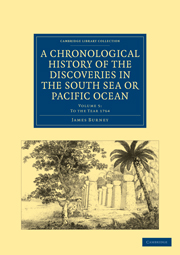Book contents
- Frontmatter
- Contents
- CHAPTER I The Carolinas, or New Philippine Islands
- CHAP. II Voyage of Lozier Bouvet, in 1738-9, to search for Lands in the Southern Atlantic Ocean
- CHAP. III Voyage round the World, by Commodore George Anson
- CHAP. IV Wreck of the British Frigate the Wager; and the subsequent Proceedings and Adventures of Captain David Cheap, and his Ship's company
- CHAP. V Missionary Voyage to Patagonia. Voyage of the French Ship Le Condé of St. Malo
- CHAP. VI Voyage of the Spanish Ship Leon, to Chili and Peru; and her Return to Europe
- CHAP. VII Monsieur de Bougainville to the Malouines, or Falkland Islands
- CHAP. VIII Of Islands marked in the Charts of the Pacific Ocean, and in the Tables of Situations, concerning which no other notices are found
- CHAP. IX CONCLUDING CHAPTER
- Index
- Plate section
CHAP. VI - Voyage of the Spanish Ship Leon, to Chili and Peru; and her Return to Europe
Published online by Cambridge University Press: 05 August 2011
- Frontmatter
- Contents
- CHAPTER I The Carolinas, or New Philippine Islands
- CHAP. II Voyage of Lozier Bouvet, in 1738-9, to search for Lands in the Southern Atlantic Ocean
- CHAP. III Voyage round the World, by Commodore George Anson
- CHAP. IV Wreck of the British Frigate the Wager; and the subsequent Proceedings and Adventures of Captain David Cheap, and his Ship's company
- CHAP. V Missionary Voyage to Patagonia. Voyage of the French Ship Le Condé of St. Malo
- CHAP. VI Voyage of the Spanish Ship Leon, to Chili and Peru; and her Return to Europe
- CHAP. VII Monsieur de Bougainville to the Malouines, or Falkland Islands
- CHAP. VIII Of Islands marked in the Charts of the Pacific Ocean, and in the Tables of Situations, concerning which no other notices are found
- CHAP. IX CONCLUDING CHAPTER
- Index
- Plate section
Summary
This was a Mercantile Voyage, and proved also to be a Voyage of Discovery. An abstract of a Journal kept by le Sieur Ducloz Guyot, a seaman of St. Malo, who sailed in the Leon, was communicated by M. d'Apres de Mannevillette to Mr. Dalrymple, who published it in the original French language, in his Collection of Voyages in the Southern Atlantic.
The Leon, a Spanish ship, sailed from Cadiz December the 14th, 1753. So general an eagerness for going to the Spanish Indies prevailed at that time in Spain, that the Commander of the Leon found it necessary to stop at the Island Teneriffe, to rid the ship of no less than sixty persons who had secreted themselves on board, and had kept themselves concealed, till she was clear out at sea. Nothing else occurred remarkable in the outward passage. The European cargo was disposed of in part at Valparaiso, and in part at Callao, at the latter of which places the ship lay sixteen months.
In the beginning of April, 1756, the Leon was freighted with a good homeward bound cargo, having on board her gold and silver, amounting in value to 3,260,560 dollars; 40,000 lbs. of cacao; 342 quintals of brass; 400 of block tin in bars; 440 of wool of the Peruvian sheep; 225 of bezoar; 200 of balsam; and 150 thousand weight of Jesuits bark, as well for medicine as for dying; the value of the whole estimated at, M. Duclog says, ‘22,000,000 de notre monnoye.’
- Type
- Chapter
- Information
- Publisher: Cambridge University PressPrint publication year: 2011First published in: 1817



